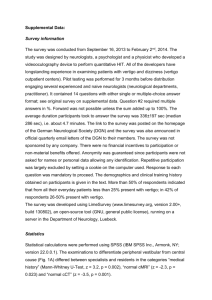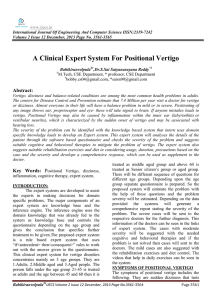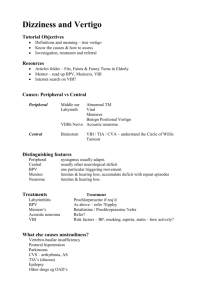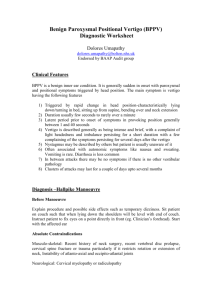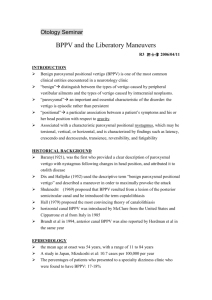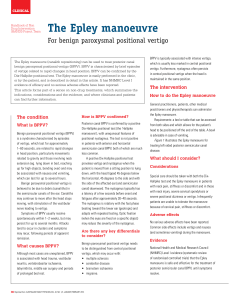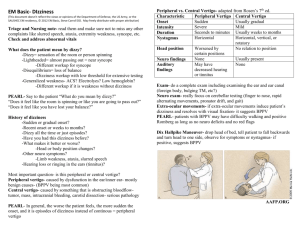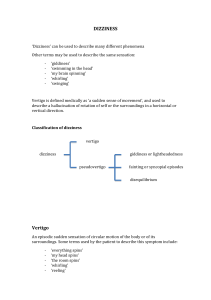Benign Paroxysmal Positioning Vertigo -1
advertisement
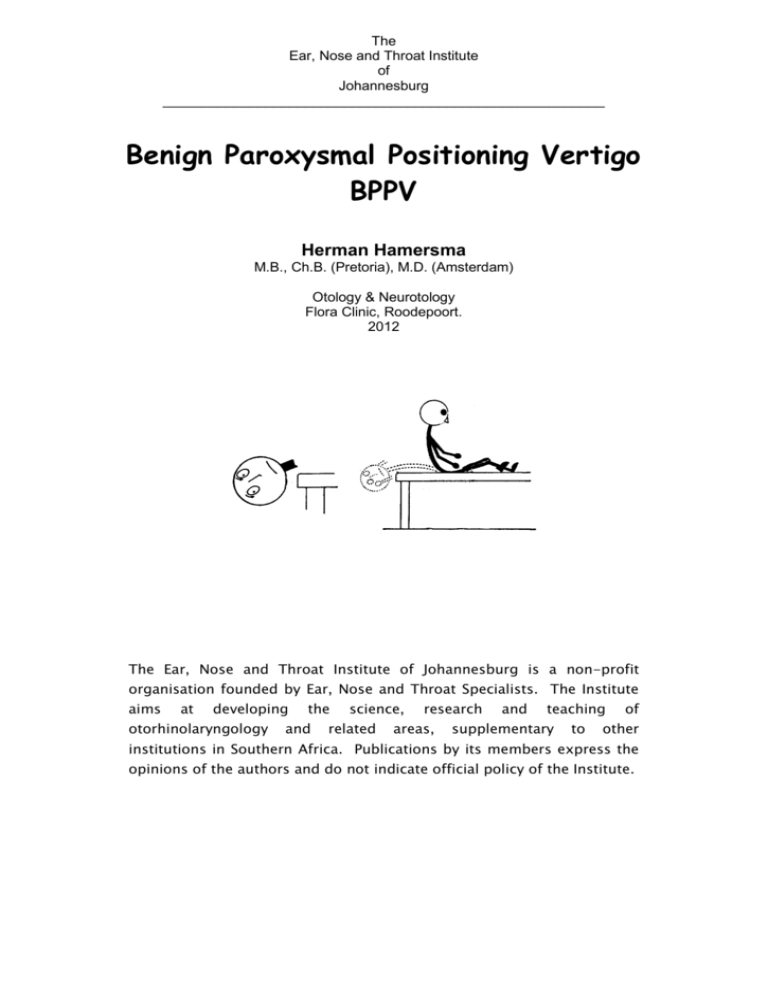
The Ear, Nose and Throat Institute of Johannesburg ________________________________________________________ Benign Paroxysmal Positioning Vertigo BPPV Herman Hamersma M.B., Ch.B. (Pretoria), M.D. (Amsterdam) Otology & Neurotology Flora Clinic, Roodepoort. 2012 The Ear, Nose and Throat Institute of Johannesburg is a non-profit organisation founded by Ear, Nose and Throat Specialists. The Institute aims at developing otorhinolaryngology the and science, related research areas, and teaching supplementary to of other institutions in Southern Africa. Publications by its members express the opinions of the authors and do not indicate official policy of the Institute. Benign Paroxysmal Positioning Vertigo (BPPV) is characterized by sudden, brief episodes of severe rotational dizziness (a spinning sensation, i.e. true vertigo) lasting seconds to minutes only, accompanied by jerky eye movements (nystagmus), which follow on rapid changes in head position. Positional vertigo was originally defined by Bárány (Vienna, Austria and Uppsala, Sweden) in 1921. Bárány described the disorder in a 27-year old woman and he wrote as follows: “The attacks only appeared when she lay on her right side. When she did this, there appeared a strong rotatory nystagmus to the right. The attack lasted about 30 seconds and was accompanied by violent vertigo and nausea. If, immediately after the cessation of symptoms, the head was again turned to the right, no attack occurred and in order to evoke a new attack in this way, the patient had to lie for some time on her back or on her left side.” The term Benign Paroxysmal Positional Vertigo (BPPV) was introduced by Dix and Hallpike (London) in 1952. They also described the provocation test by which to elicit the vertigo – see next page. The term positioning (posisionering, Lagerung) vertigo is more accurate than positional (posisie, Lage) because it is the movement itself which initiates the vertigo and not the end position of the head. In the literature the term positioning is now gradually replacing the term positional. Otoconia. This scanning electron micrograph shows the configuration of human otoconia. Each crystal has an oblong form, and the tips have three surfaces. The cause of this remarkable positional vertigo remained uncertain, until Prof. Schuknecht of Harvard university, Boston, U.S.A., published his famous cupulolthiasis article in 1969. During routine examination of temporal bones of patients who died from unrelated causes (but who did have a history of occasional vertigo some time before death), debris was sometimes found on the cupula of the posterior vertical semicircular canal, and Schuknecht hypothesized that these originated from otoconia (calcium crystals), which had broken loose from s degenerated utricle and eventually settled on the cupula of the canal closest to the utricle, i.e., the posterior semicircular canal. When the endolymph fluid in this canal was brought into movement by means of a head movement in the plane of the canal, the cupula was heavier on the side facing the vestibule, resulting in a longer time necessary for the cupula to return to its normal position after cessation of the head movement. During this extended time of cupular deflection, the patient then experienced the vertigo. Schuknecht suggested the term “cupulolithiasis”. In 1979 Hall et al proposed the “canalith” explanation, i.e. free-moving densities in the endolymph of the posterior vertical semicircular canal on the other side of the cupula. These densities, if originating from the utricle, could only reach the canal side of the ampulla via the common crus. Canalolithiasis explains all the features of BPPV: latency, short duration, fatiguability (diminution with repeated positioning), changes in direction of nystagmus with changes in head position, and the efficacy of physical therapy. In 1992 Parnes and McClure (London, Ontario, Canada) demonstrated free densities, resembling accumulations of displaced otoconia, in the distal sections of the posterior semicircular canals of two patients undergoing surgery for BPPV. Today it is accepted that “canalolithiasis” occurs more frequently than “cupulolithiasis”.


